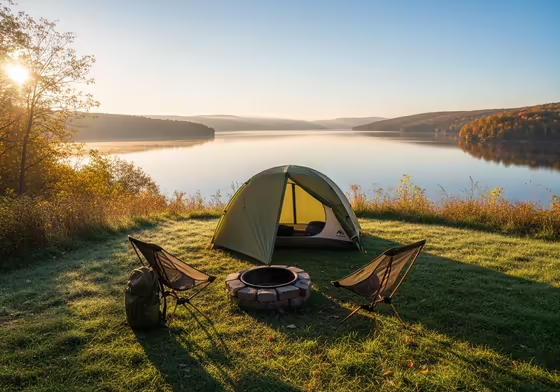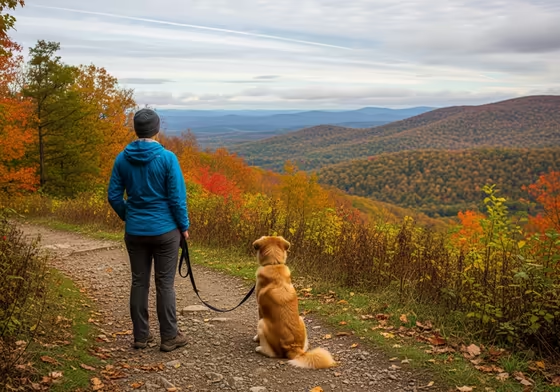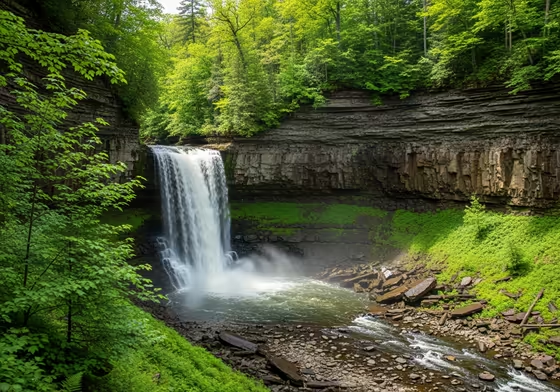How to Be a Good Camper in the Finger Lakes
The Finger Lakes area is beautiful, with its gorges, waterfalls, and lakes. Taughannock Falls and Watkins Glen are amazing places to visit. So many people camp here that it can be tough on the land and on other campers.

This guide will show you how to take care of these parks for everyone. The most important idea is the "Golden Rule" of camping. Just treat other people and the outdoors with respect.
The Main Ideas of Good Camping
To be a good camper, you need to know why the rules exist. It all comes down to a couple of simple ideas.
The Golden Rule: Be Respectful
So what's the number one rule of camping? It's all about respect. You need to show respect in three main ways.
- Respect nature. The outdoors is for everyone, so we need to protect it. The best way to do this is by following the Leave No Trace rules.
- Respect other campers. Campgrounds are shared spaces. Be mindful of your noise, lights, and how much space you take up.
- Respect the rules. Things like quiet hours and pet rules are there for a reason. They help everyone stay safe and get along.
Most camping rules fit into these two big ideas. The Golden Rule is about being respectful. Leave No Trace is how you apply that respect to nature.
Leave No Trace: The 7 Rules
Leave No Trace (LNT) is the most important set of rules for protecting the outdoors. Here are the 7 principles that help you lower your impact.
Principle 1: Plan Ahead and Prepare
Good planning prevents problems. Know the rules for the area you're visiting, like if campfires are allowed. Check the weather, bring the right gear, and repackage food to have less trash.
Principle 2: Stick to Trails and Campsites
This protects plants and soil. Stay in your campsite and on marked trails. In wilder areas, camp on hard surfaces like rock or dry grass, not on fragile plants.
Principle 3: Pack Out Your Trash
The rule is "Pack it in, pack it out." This means all your trash, including food scraps. If a trash can is full, you have to take your garbage home with you.
Principle 4: Leave What You Find
Leave the outdoors how you found it. A good saying is, "Take only pictures, leave only footprints." Don't build things or take rocks and plants home.
Principle 5: Be Careful with Fire
If fires are allowed, use the fire rings that are already there. Keep your fires small. Make sure all the wood burns to ash and the fire is completely out before you leave.
Principle 6: Respect Wildlife
Watch animals from a distance. Never, ever feed them. It's bad for their health and can make them aggressive, which is dangerous for everyone.
Principle 7: Be Kind to Other Visitors
This rule is about sharing the space. Let people enjoy the sounds of nature. Avoid loud noises and music so everyone can have a good experience.
Table 1: The 7 LNT Principles at a Glance: Finger Lakes Edition
| Principle | Key Action | Why It Matters (The Finger Lakes Context) |
|---|---|---|
| 1. Plan Ahead and Prepare | Research park-specific pet and firewood rules. | Keeps you from getting turned away from the Watkins Glen Gorge Trail (no pets allowed) or breaking firewood laws. |
| 2. Travel & Camp on Durable Surfaces | Stick to your designated campsite and official trails. | Protects plants and stops soil from washing away in the gorges and along the lake. |
| 3. Dispose of Waste Properly | Pack out all trash, including food scraps. | Prevents wildlife from being attracted to campsites. If bins are full, you must take your trash home with you. |
| 4. Leave What You Find | Do not take rocks, plants, or build "improvements." | Preserves the natural state of the gorges and forests for the next visitor. "Take only pictures, leave only footprints". |
| 5. Minimize Campfire Impacts | Use designated rings and "Buy It Where You Burn It." | This is a critical regional rule. Moving firewood spreads invasive species like the Spotted Lanternfly, which threatens the Finger Lakes' entire grape and apple economy. |
| 6. Respect Wildlife | Never feed animals. Store food securely. | Feeding wildlife (even raccoons or ducks) changes their natural behavior and ultimately endangers them. |
| 7. Be Considerate of Other Visitors | Control noise and light. | Sound travels far over the lakes and across gorges. Respecting others' experience is a core part of LNT. |
Campground Do's and Don'ts
Here are some practical tips for being a good camper.

At Your Campsite
Noise Control
- Quiet Hours: Most campgrounds have quiet hours, usually from 10 PM to 7 AM. During this time, keep all sounds at your site. This includes voices, music, and generators.
- Daytime Noise: Be mindful of noise during the day too. Sound travels far, especially over water. Keep conversations at a normal volume.
- Music: Not everyone wants to hear your music. Keep it low or use headphones. This lets you enjoy your tunes without bothering your neighbors.
Light Discipline
Lots of people camp to see the stars. Bright lights can ruin that experience for others. Be mindful of your lanterns and RV lights.
- Point your lights down toward the ground. Turn off bright outside lights when you go to bed or when quiet hours start.
- Be careful with headlamps so you don't shine them in people's faces. Using the red light setting is a good idea. It's less harsh and helps you see better in the dark.
Respecting Site Boundaries
Think of a campsite as someone's temporary home. Never cut through another person's campsite, even if it's empty. Always use the roads and paths to get around the campground.
Generator Rules
Generators can be very loud and annoying to others. Follow the posted hours for running generators. If you need to run an air conditioner all night, you should get a campsite with electricity.
In Shared Areas
Bathrooms
The rule here is simple: leave them cleaner than you found them. Clean up any water or dirt you make. Don't take too long in the shower so others can use it.
Water Spigots and Washing Dishes
This is where a lot of new campers make mistakes.
- Use water spigots just for filling up your water containers.
- Do not wash dishes, yourself, or your gear at the spigot. This makes a gross, muddy mess that attracts bugs and animals.
- The right way to wash dishes is at a dishwashing station. If there isn't one, carry your water far away from lakes or streams, use a little biodegradable soap, and scatter the leftover water.
Trail Rules
Follow these rules on trails to be safe and polite.
- People hiking uphill have the right of way. If you're going down, step aside to let them pass.
- Bikers should yield to hikers.
- Everyone yields to horses. Move off the trail on the downhill side, as horses can get scared easily.
Trash Cans
Use the trash cans provided. Your fire pit is not a trash can. If a bin is full, don't just leave your trash next to it. You must pack it out and take it home with you.
Campfires and Firewood
Fire Safety
- Only use the fire rings that are already there.
- Never leave a fire unattended, even for a second.
- Putting It Out: Drown the fire with water, stir the ashes, and drown it again. Keep doing this until you can touch the ashes safely. A fire that seems out can still be hot underneath and start a wildfire.
Firewood Rules (Very Important!)
The rule is "Buy It Where You Burn It." This isn't just a friendly tip; it's a New York State law. Here's why it matters so much.
- The law in New York says you can't move untreated firewood more than 50 miles. You also cannot bring it in from another state.
- This rule is important because it stops the spread of harmful bugs that kill trees.
-
Moving firewood threatens the Finger Lakes area with pests like:
- Emerald Ash Borer, which has already killed many ash trees.
- Spotted Lanternfly, which is a major threat to the local grapevines and apple trees.
- Other pests that harm maple and oak trees.
Camping With Your Pet
The B.A.R.K. rules are a good way to remember how to camp with your pet.
- B - Bag your pet's waste. Always pick it up and put it in a trash can.
- A - Always leash your pet. Keep your pet on a 6-foot leash at all times. This is for everyone's safety and comfort.
- R - Respect wildlife. Don't let your pet chase or bark at wild animals.
- K - Know where you can go. Some trails and areas do not allow pets, so plan ahead.
- Control Barking: Don't let your dog bark all the time. Quiet hours are for dogs, too.
- Keep Them Safe: Never leave your pet alone at the campsite.
Arriving and Leaving
Arrival
Try to arrive during the day. Setting up in the dark is loud and can bother people who are trying to sleep. If you know you'll be late, call the campground. Be as quiet as you can when you get there and save most of your setup for the morning.
Departure
Leave your campsite by the check-out time. Your goal should be to leave the campsite cleaner than you found it. Do a final walk-through to pick up any tiny bits of trash, and make sure your fire is completely cold.
Rules for the Finger Lakes
General rules are great, but you also need to know the specific rules for Finger Lakes parks.

Camping in Finger Lakes Parks
Booking Your Site
This goes back to planning ahead. Campsites in popular parks can fill up nine months in advance. Know the rules about minimum stays and cancellations before you book.
Know the Park-Specific Pet Rules
Many problems happen when people don't know the specific rules for the park they are visiting. This is especially true for pets.
- Taughannock Falls State Park: You can have two pets, but they need a leash and proof of rabies shots.
- Watkins Glen State Park: Same rules as Taughannock, but pets are not allowed on the main Gorge Trail at all.
- Robert H. Treman State Park: Same pet rules, but pets are not allowed on the Gorge Trail or in the swimming area.
These rules aren't random. They protect the most crowded and sensitive areas, like the narrow gorge trails. If you don't plan ahead, you might not be able to see the main attraction with your pet.
Table 2: Pet Policies at Iconic Finger Lakes State Parks
| Park | Max Pets | Proof of Rabies | Pets on Gorge Trail? | Pets in Swimming Area? |
|---|---|---|---|---|
| Taughannock Falls | 2 | Required at check-in | Yes (on trails) | Not specified |
| Watkins Glen | 2 | Required at check-in | No | Not specified |
| Robert H. Treman | 2 | Required at check-in | No | No |
Free Camping in the National Forest
Dispersed camping means camping outside of a campground. There are no bathrooms, no trash cans, and no running water. It's totally free, but you have to be more responsible.
FLNF-Specific Rules
- You can only camp for 14 days within a 30-day period.
- Campsites must be at least 50 feet from ponds, streams, or trails.
- Fires are allowed only in existing fire rings. You can gather dead wood that's on the ground, but you still can't bring in firewood from more than 50 miles away.
How to Go to the Bathroom Outside
Since there are no toilets, you need to know how to properly dispose of human waste. Here’s how to dig what’s called a "cathole."
- Go at least 200 feet (about 70 big steps) away from water, trails, and campsites.
- Dig a hole that is 6 to 8 inches deep.
- Do your business in the hole.
- Fill the hole back in with the dirt you dug up. Cover it with leaves to make it look natural again.
- Toilet Paper: You must pack out your used toilet paper. Do not bury it. Bring a dark-colored plastic bag to carry it out in.
Be a Good Camper
So, what's the most important rule of camping? It's Leave No Trace.
Being quiet and respecting your neighbors makes camping fun for everyone. Following Leave No Trace makes sure the parks stay beautiful for years to come.
The goal is simple. We want everyone to have a good time and we need to protect the beauty of the Finger Lakes. These rules help us do that. When you camp with respect, you help protect these amazing places for everyone.
